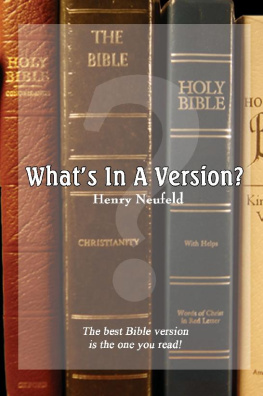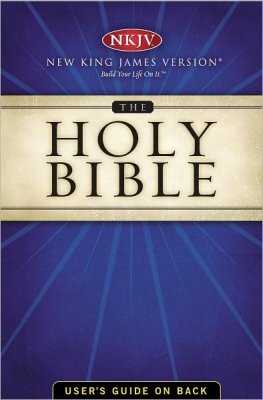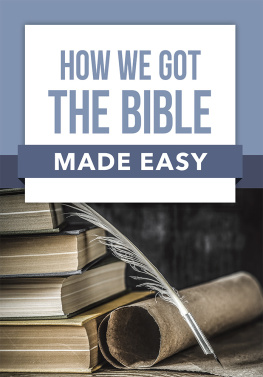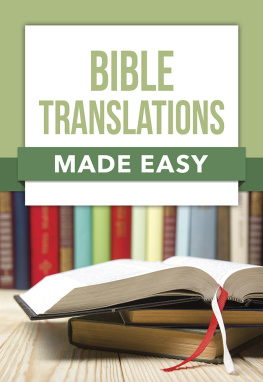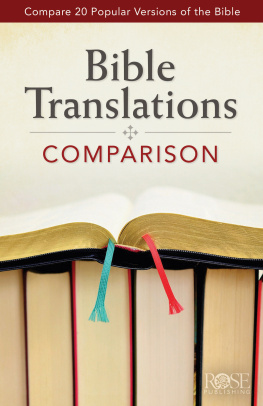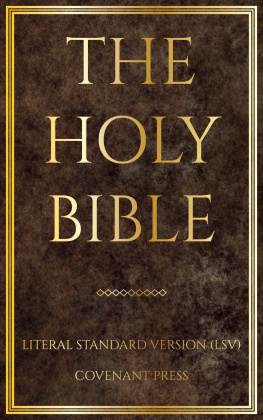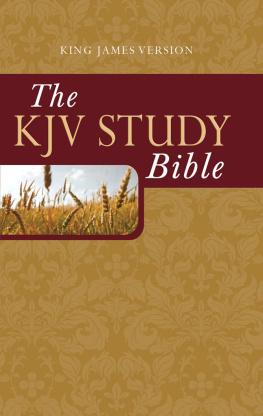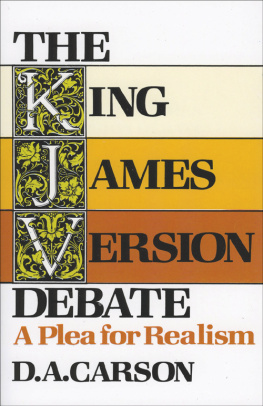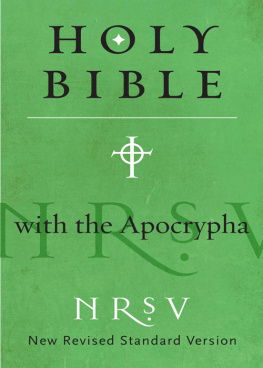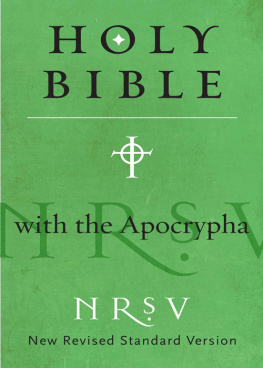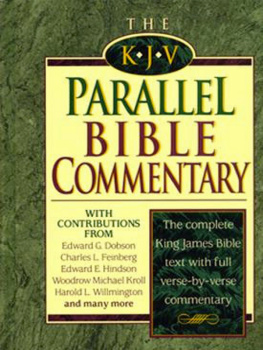What's in a Version?
by
Henry E. Neufeld
Energion Publications
P. O. Box 841
Gonzalez, FL 32560
(850) 968-1001
http://energion.com
Energion Publications
P. O. Box 841
Gonzalez, FL 32560
Scripture quotations marked CEV are taken from the Contemporary English Version , Copyright 1995 American Bible Society .
Scripture quotations marked CJB are from the Complete Jewish Bible . Copyright 1998 by David H. Stern.
Scripture quotations marked ESV are from the Holy Bible, English Standard Version , Copyright 2001. by Crossway Bibles, a division of Good News Publishers. Used by permission. All rights reserved.
Scripture quotations marked LB are taken from The Living Bible , Copyright 1971 by Tyndale House Publishers, Wheaton, Illinois 60187 . All rights reserved.
Scripture quotations marked NASB95 are from the New American Standard Bible , Copyright 1960, 1962, 1963, 1968, 1971, 1972, 1973, 1975, 1977, 1995 by The Lockman Foundation. Used by permission. Quotations marked NASB are from an earlier edition of that version and are used only for illustration.
Scripture quotations marked NCV are from The Holy Bible , New Century Version , Copyright 1987, 1988, 1991 by Word Publishing, Dallas, Texas 75039 . Used by permission.
Scripture quotations marked NIV are taken from the HOLY BIBLE, NEW INTERNATIONAL VERSION. Copyright 1973, 1978, 1984 by International Bible Society. Used by permission of Zondervan Publishing House. All rights reserved.
Scripture quotations marked NKJV are taken from the New King James Version . Copyright 1982 by Thomas Nelson, Inc. Used by permission. All rights reserved.
Scripture quotations marked NLT are taken from the Holy Bible , New Living Translation , Copyright 1996. Used by permission of Tyndale House Publisher, Inc., Wheaton, Illinois 60189, All rights reserved.
Scripture quotations marked NRSV are taken from the New Revised Standard Version Bible , copyright 1989 by the Division of Christian Education of the National Council of the Churches of Christ in the U. S. A. Used by permission. All rights reserved.
Scripture Quotations marked Phil or Phillips are from The New Testament in Modern English, Copyright 1958 by J. B. Phillips.
Scripture quotations marked REB are from the Revised English Bible , Copyright 1989 by Oxford University Press and Cambridge University Press.
Scripture quotations marked TM are taken from THE MESSAGE. Copyright 1993, 1994, 1995, 1996, 2000, 2001, 2002. Used by permission of NavPress Publishing Group.
Unmarked translations are by the author.
Cover Photo and Layout by Baxter's Elite Productions, www.baxterselite.com
Copyright 1996, 2004, Henry E. Neufeld
ISBN: 1-893729-20-6 (Paperback)
978-1-63199-347-3 (Electronic ISBN)
Preface
Why another book about Bible translation?
There are many books reviewing versions (Kubo & Specht, "So Many Versions") or dealing with the arguments between advocates of the King James Version and of modern versions. What I have found in discussing this issue is that many people don't understand the basics of how translations are made. They get caught up in the arguments without understanding the foundation. This book is not about arguing the merits of one translation over another. In particular it is not about arguing the merits of the King James Version of the Bible as opposed to modern versions. It is about laying a foundation.
What I intend to do in this book is present an overview of how translations are produced, what makes them different from one another and how a reader who doesn't know the source language s (Hebrew , Aramaic and Greek ) can choose a version or versions of the Bible for use. Since many people don't know how the Bible came into existence, how its text has been preserved, and how translation is accomplished, they are subject to misinformation. The differences between the various versions can be frightening when they are not understood. How can there be so many differences unless someone is being careless, or even worse, someone is intentionally altering God s word?
I have kept this book short intentionally and interspersed it with many illustrations. It is not intended for a scholarly audience, but rather for the layperson who wants some practical information. The Bibliography contains a list of works for those who want to explore the subject of translations more extensively.
I have been helped by many people in preparing to write this book. First, I want to thank my uncle, Don F. Neufeld, who introduced me to the study of both Greek and of Hebrew , and to those professors of Greek and Hebrew who helped me along the way. I want especially to thank Dr. Alden Thompson of Walla Walla College who helped me to better understand a God who could work providentially in many different ways, and not just in those ways I expected Him to.
A number of classes and study groups have suffered through this material and tolerated my enthusiasm for minor details of translation theory, as have many people with whom I have discussed, both in person and via electronic mail. I enjoyed (and still enjoy) talking with you all.
Most of all I want to thank those people who, under the guidance of God , worked to preserve the treasure of the Bible in times when it was not nearly so easy as now. Many of them lost their lives in that work. They spent years for what takes us only days or weeks, yet they persevered. It is to them we owe the greatest thanks.
Introduction
The Bible is the most translated work in history. Many thousands of experts work on its translation year after year as they have been for centuries. Why is it then that there are such differences between one translation and another and such disagreement as to which translation one should use? Is it that difficult to determine what the Bible actually says and then just say it in English, or whatever language one is translating into?
The answer to these questions can be found in the nature of the Bible, how it was composed, how it was transmitted, and how translators go about expressing its meaning in a language other than the one in which it was written.
A number of factors make translations different. These include the source language manuscripts that the translators use, the people who translate and their intent, the method of translation, and the audience for whom they translate. There are many individual decisions that go into each of these elements, but the average reader may not even notice . These include capitalization , use of language related to gender , converting weights and measures , punctuation and section headings, amongst others.
Im going to examine these from the laypersons point of view, always asking how these difference change the way you use the Bible, whether in public reading or private, orally or silently, in worship or in a study group.
As a guide to help you find the information you want in this book, here are the chapter headings and a brief description of the contents.
1. What Goes into a Bible Version?
An overview of the translation process, looking at what goes into a Bible version. The next several chapters will go into greater detail about this short explanation. Some will want to just read this chapter and then go on to the list of Bible versions at the end.
2. The Biblical Text
This chapter starts with how the Bible was written including some notes on inspiration, then goes on to discuss how it was copied and preserved. One important aspect of a modern version is the text used. How can we be as certain as possible that we are looking at a translation of what the apostles and prophets wrote?
3. Translators
Who does the work of translation? Ill discuss translators, their qualifications, their faith and motivations and even their character. How does all this impact the translation you hold in your hands?
Next page
